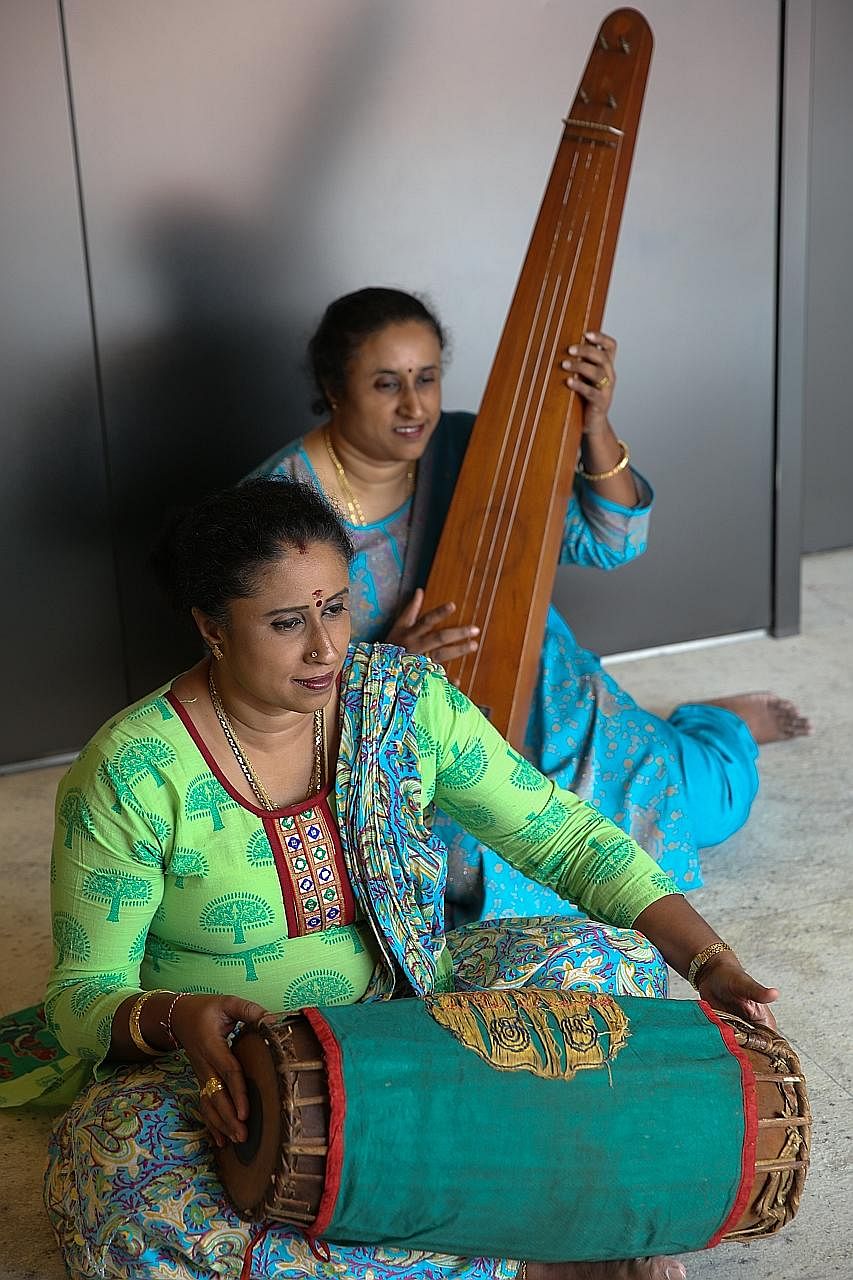A 1939 mridangam - a double-headed drum once played by the late percussionist M.V. Gurusamy - sat on a home altar for 28 years.
His granddaughter, Ms Shashikala Samugan Nathan, 45, had created and maintained the altar, sharing his story with relatives and visitors to her home.
In 2015, she decided that she wanted to broaden this audience. After all, her grandfather was a music legend who had performed and taught in Malaya in the 1930s and early 40s before arriving in Singapore in 1942. He had also been a member of the cultural contingent led by then Minister for Culture S. Rajaratnam which performed in Sarawak, Brunei and Sabah in 1965.
So she contacted the Indian Heritage Centre (IHC) to donate 34 artefacts and other items from his collection, including his tambura - a long-necked plucked string instrument - through its artefact collection drive.
Ms Shashikala, who had to sign a deed of gift with the National Heritage Board (NHB) which manages the IHC, described the experience of donating the items as "quite a smooth and coordinated process" that took just a month.
The deed of gift has been in the spotlight as a result of the 38, Oxley Road saga involving Prime Minister Lee Hsien Loong and his siblings.
In the Lee family case, the deed has to do with the donation of items from the late Mr Lee Kuan Yew's house to the NHB.

Ms Shashikala explained why she contributed to the IHC: "My grandfather's passion for music was so great, he was still playing the day before he died. I wanted his memory to live on beyond just our family and I wanted to share his life with newer generations, for his story to be archived for good. I thought of donating so that the nation can see his accomplishments for themselves."
Last year, NHB recognised nine donors who made artefact donations to the NHB's museums and institutions at its Patron of Heritage Awards. Donations can be in the form of cash or artefacts, including antiques, art works, jewellery, clothing and documents.
Items that have been donated to NHB include:
• 152 pieces of Peranakan jewellery and porcelain ware once owned by prominent philanthropist Tan Kim Seng, to the Peranakan Museum.
• A collection of war-time publications from Singapore's sixth president, Mr S R Nathan, to the IHC.
• A set of the first uniform issued by the Singapore Armed Forces, to the National Museum of Singapore.
The deed of gift itself is a legal agreement between the donor and recipient to document the transfer of gifts between the two parties. It applies only in the specific case where a donor gives an artefact or a collection of artefacts.
NHB's spokesman said its standard deed of gift contains, among other things, clauses on the transfer of the artefact(s), provisions on intellectual property rights, warranties on the part of the donors on ownership, accuracy of information provided, and their capacity to enter into the agreement without needing the consent of other parties.
If required, a clause on the acknowledgement of the donor is also included. This refers to how the donor would be credited when the gift is displayed.
The spokesman said gifts usually come through NHB's museums, and are assessed by its curators and museum directors. All donations are evaluated according to their significance and relevance to the National Collection which aims to reflect the country's history, development and memories, as well as its interconnectedness with the region and the world, she added.
Most of the items belonging to Singapore's first prime minister are displayed at the ongoing We Built A Nation exhibition at the National Museum of Singapore. A donor may approach the museum directly on his intent to donate, or museums may seek donations from individuals, such as private collectors.
During this process, negotiations might take place, said the spokesman. For instance, donors may ask the museum for assurance that the collection is accepted or displayed in its entirety, or in the case of the donation of a very large and significant collection of artefacts, donors may ask for the naming rights to a gallery.
Examples include the Goh Seng Choo Gallery at the National Museum of Singapore and the Khoo Teck Puat Gallery at the Asian Civilisations Museum.
NHB's spokesman said it seeks legal counsel on the conditions and clears "any onerous or non-standard conditions" with its chief executive, as was the case with the donation from 38, Oxley Road.
She added: "Where necessary, NHB would seek the Ministry of Culture, Community and Youth's policy guidance and advice. As part of due diligence, the museums and NHB also conduct provenance checks on the objects to be donated."
Once all parties are satisfied, the donor will then sign the deed of gift.
Former IHC director Gauri Krishnan, now an independent curator, said personal donations add value to existing museum content. For instance, she said, much of IHC's collection was gathered through a community collection drive. "A lot of potential donors we encountered were surprised that they were holding on to a piece of history worthy of preservation and display in a museum," she added.
Mr Kennie Ting, the group director of museums at NHB, said: "A gift is often the culmination of an extended conversation and process of relationship-building between museum and donor. Every gift is important to us and every donor has a different reason as to why they give.
"For some, it is with the view that an artefact of historical or cultural significance should be shared with a wider audience, and the museum is a good place to do this. For others, a gift is a means of honouring and remembering the legacy of members of their family who came before them."

